Assessment 2: Case study on routine subcutaneous insulin medication order
VerifiedAdded on 2023/06/07
|7
|2162
|113
AI Summary
This case study discusses the routine subcutaneous insulin medication order, Novo Rapid insulin, and its effects on type 1 diabetes. It also covers the 5 rights of medication administration, hypoglycaemia, and the importance of understanding medication prior to administration.
Contribute Materials
Your contribution can guide someone’s learning journey. Share your
documents today.
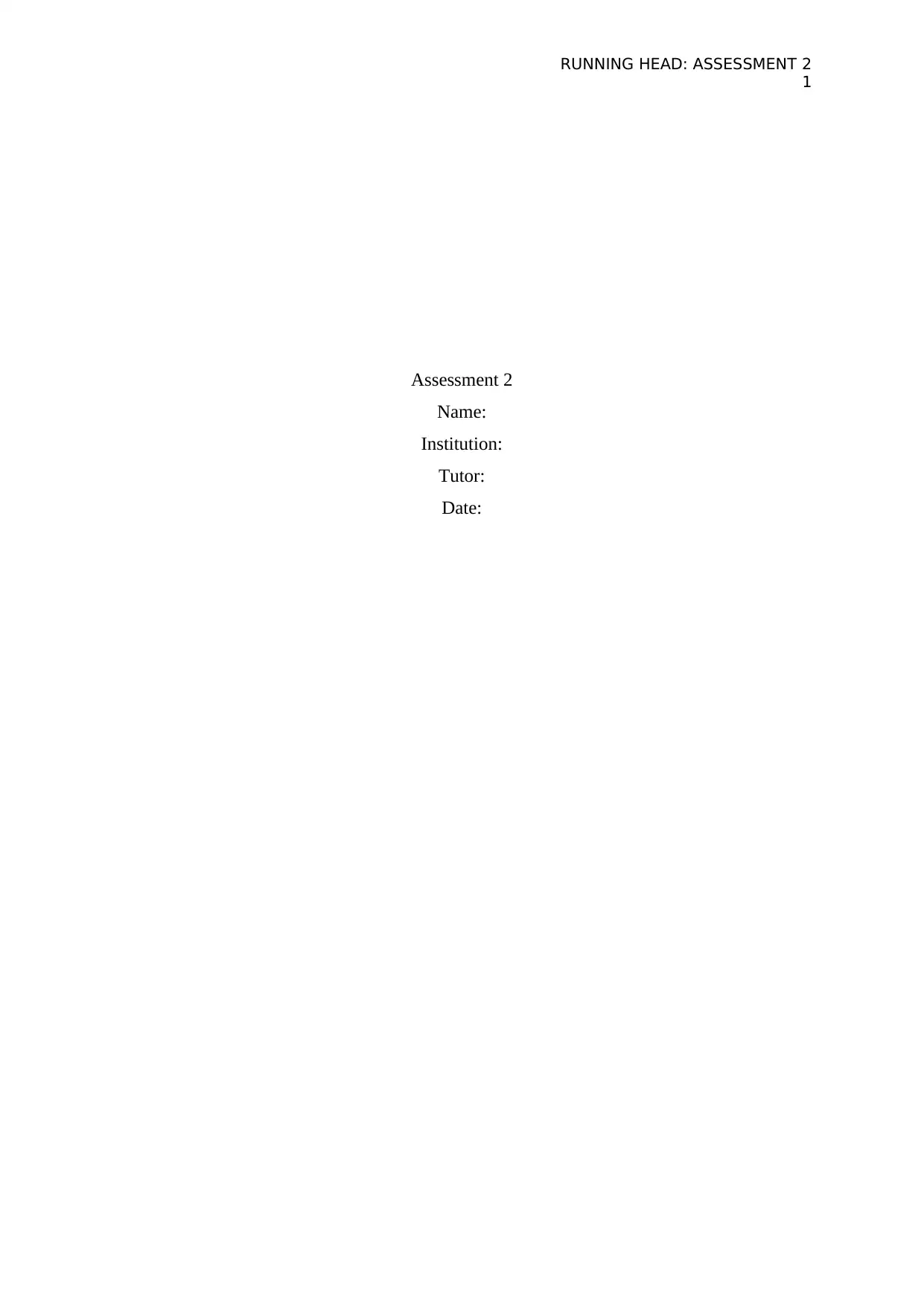
RUNNING HEAD: ASSESSMENT 2
1
Assessment 2
Name:
Institution:
Tutor:
Date:
1
Assessment 2
Name:
Institution:
Tutor:
Date:
Secure Best Marks with AI Grader
Need help grading? Try our AI Grader for instant feedback on your assignments.
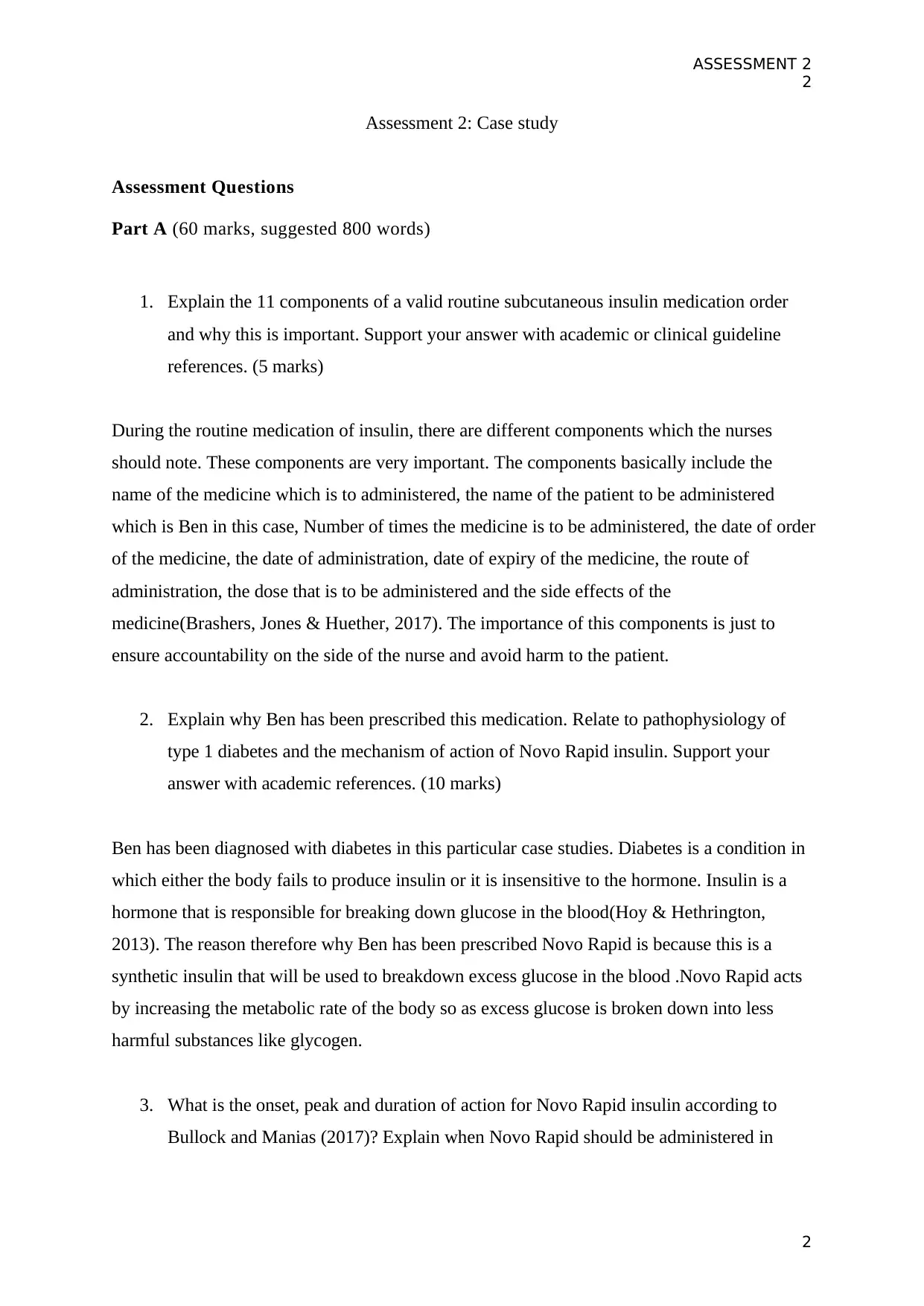
ASSESSMENT 2
2
Assessment 2: Case study
Assessment Questions
Part A (60 marks, suggested 800 words)
1. Explain the 11 components of a valid routine subcutaneous insulin medication order
and why this is important. Support your answer with academic or clinical guideline
references. (5 marks)
During the routine medication of insulin, there are different components which the nurses
should note. These components are very important. The components basically include the
name of the medicine which is to administered, the name of the patient to be administered
which is Ben in this case, Number of times the medicine is to be administered, the date of order
of the medicine, the date of administration, date of expiry of the medicine, the route of
administration, the dose that is to be administered and the side effects of the
medicine(Brashers, Jones & Huether, 2017). The importance of this components is just to
ensure accountability on the side of the nurse and avoid harm to the patient.
2. Explain why Ben has been prescribed this medication. Relate to pathophysiology of
type 1 diabetes and the mechanism of action of Novo Rapid insulin. Support your
answer with academic references. (10 marks)
Ben has been diagnosed with diabetes in this particular case studies. Diabetes is a condition in
which either the body fails to produce insulin or it is insensitive to the hormone. Insulin is a
hormone that is responsible for breaking down glucose in the blood(Hoy & Hethrington,
2013). The reason therefore why Ben has been prescribed Novo Rapid is because this is a
synthetic insulin that will be used to breakdown excess glucose in the blood .Novo Rapid acts
by increasing the metabolic rate of the body so as excess glucose is broken down into less
harmful substances like glycogen.
3. What is the onset, peak and duration of action for Novo Rapid insulin according to
Bullock and Manias (2017)? Explain when Novo Rapid should be administered in
2
2
Assessment 2: Case study
Assessment Questions
Part A (60 marks, suggested 800 words)
1. Explain the 11 components of a valid routine subcutaneous insulin medication order
and why this is important. Support your answer with academic or clinical guideline
references. (5 marks)
During the routine medication of insulin, there are different components which the nurses
should note. These components are very important. The components basically include the
name of the medicine which is to administered, the name of the patient to be administered
which is Ben in this case, Number of times the medicine is to be administered, the date of order
of the medicine, the date of administration, date of expiry of the medicine, the route of
administration, the dose that is to be administered and the side effects of the
medicine(Brashers, Jones & Huether, 2017). The importance of this components is just to
ensure accountability on the side of the nurse and avoid harm to the patient.
2. Explain why Ben has been prescribed this medication. Relate to pathophysiology of
type 1 diabetes and the mechanism of action of Novo Rapid insulin. Support your
answer with academic references. (10 marks)
Ben has been diagnosed with diabetes in this particular case studies. Diabetes is a condition in
which either the body fails to produce insulin or it is insensitive to the hormone. Insulin is a
hormone that is responsible for breaking down glucose in the blood(Hoy & Hethrington,
2013). The reason therefore why Ben has been prescribed Novo Rapid is because this is a
synthetic insulin that will be used to breakdown excess glucose in the blood .Novo Rapid acts
by increasing the metabolic rate of the body so as excess glucose is broken down into less
harmful substances like glycogen.
3. What is the onset, peak and duration of action for Novo Rapid insulin according to
Bullock and Manias (2017)? Explain when Novo Rapid should be administered in
2
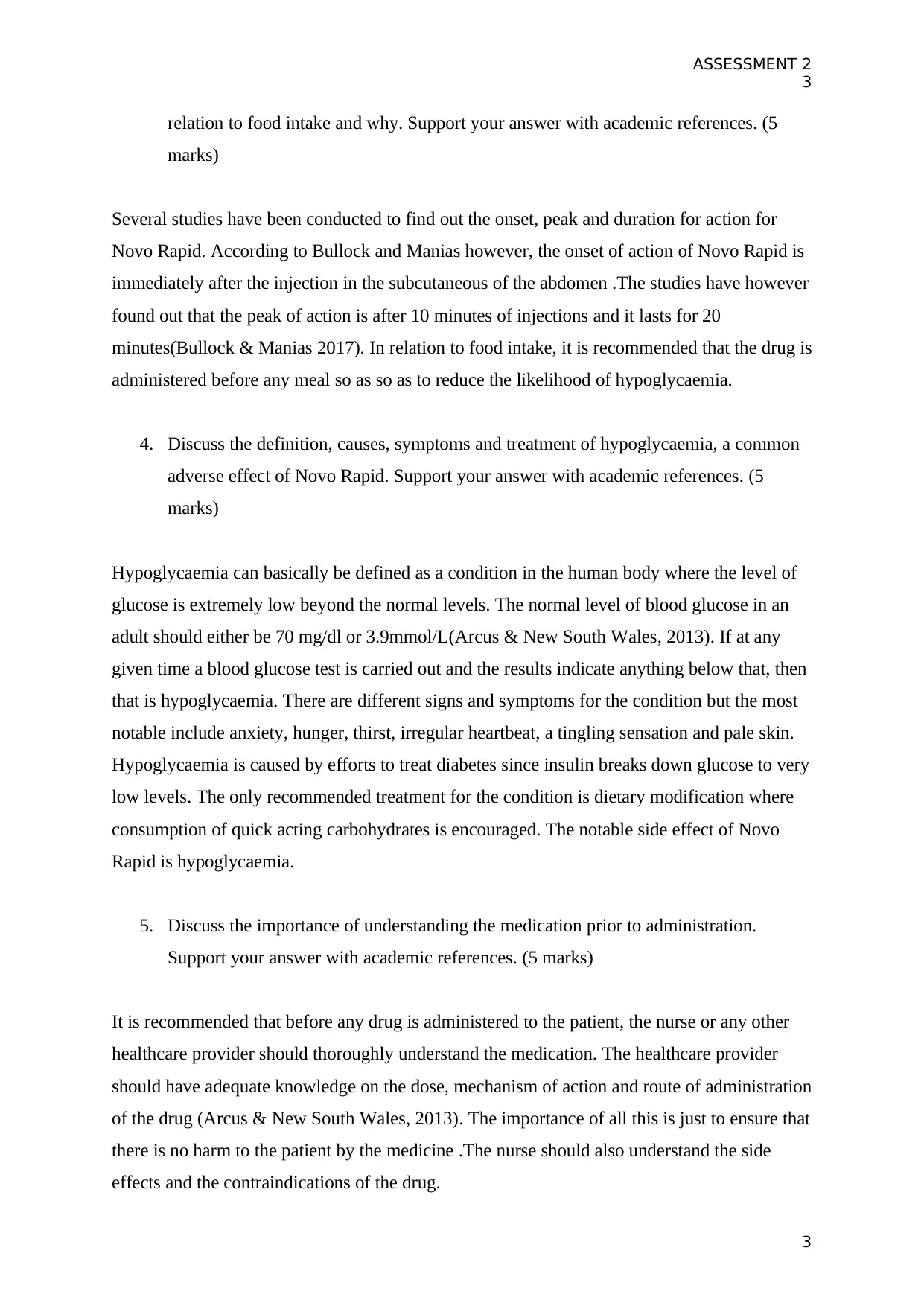
ASSESSMENT 2
3
relation to food intake and why. Support your answer with academic references. (5
marks)
Several studies have been conducted to find out the onset, peak and duration for action for
Novo Rapid. According to Bullock and Manias however, the onset of action of Novo Rapid is
immediately after the injection in the subcutaneous of the abdomen .The studies have however
found out that the peak of action is after 10 minutes of injections and it lasts for 20
minutes(Bullock & Manias 2017). In relation to food intake, it is recommended that the drug is
administered before any meal so as so as to reduce the likelihood of hypoglycaemia.
4. Discuss the definition, causes, symptoms and treatment of hypoglycaemia, a common
adverse effect of Novo Rapid. Support your answer with academic references. (5
marks)
Hypoglycaemia can basically be defined as a condition in the human body where the level of
glucose is extremely low beyond the normal levels. The normal level of blood glucose in an
adult should either be 70 mg/dl or 3.9mmol/L(Arcus & New South Wales, 2013). If at any
given time a blood glucose test is carried out and the results indicate anything below that, then
that is hypoglycaemia. There are different signs and symptoms for the condition but the most
notable include anxiety, hunger, thirst, irregular heartbeat, a tingling sensation and pale skin.
Hypoglycaemia is caused by efforts to treat diabetes since insulin breaks down glucose to very
low levels. The only recommended treatment for the condition is dietary modification where
consumption of quick acting carbohydrates is encouraged. The notable side effect of Novo
Rapid is hypoglycaemia.
5. Discuss the importance of understanding the medication prior to administration.
Support your answer with academic references. (5 marks)
It is recommended that before any drug is administered to the patient, the nurse or any other
healthcare provider should thoroughly understand the medication. The healthcare provider
should have adequate knowledge on the dose, mechanism of action and route of administration
of the drug (Arcus & New South Wales, 2013). The importance of all this is just to ensure that
there is no harm to the patient by the medicine .The nurse should also understand the side
effects and the contraindications of the drug.
3
3
relation to food intake and why. Support your answer with academic references. (5
marks)
Several studies have been conducted to find out the onset, peak and duration for action for
Novo Rapid. According to Bullock and Manias however, the onset of action of Novo Rapid is
immediately after the injection in the subcutaneous of the abdomen .The studies have however
found out that the peak of action is after 10 minutes of injections and it lasts for 20
minutes(Bullock & Manias 2017). In relation to food intake, it is recommended that the drug is
administered before any meal so as so as to reduce the likelihood of hypoglycaemia.
4. Discuss the definition, causes, symptoms and treatment of hypoglycaemia, a common
adverse effect of Novo Rapid. Support your answer with academic references. (5
marks)
Hypoglycaemia can basically be defined as a condition in the human body where the level of
glucose is extremely low beyond the normal levels. The normal level of blood glucose in an
adult should either be 70 mg/dl or 3.9mmol/L(Arcus & New South Wales, 2013). If at any
given time a blood glucose test is carried out and the results indicate anything below that, then
that is hypoglycaemia. There are different signs and symptoms for the condition but the most
notable include anxiety, hunger, thirst, irregular heartbeat, a tingling sensation and pale skin.
Hypoglycaemia is caused by efforts to treat diabetes since insulin breaks down glucose to very
low levels. The only recommended treatment for the condition is dietary modification where
consumption of quick acting carbohydrates is encouraged. The notable side effect of Novo
Rapid is hypoglycaemia.
5. Discuss the importance of understanding the medication prior to administration.
Support your answer with academic references. (5 marks)
It is recommended that before any drug is administered to the patient, the nurse or any other
healthcare provider should thoroughly understand the medication. The healthcare provider
should have adequate knowledge on the dose, mechanism of action and route of administration
of the drug (Arcus & New South Wales, 2013). The importance of all this is just to ensure that
there is no harm to the patient by the medicine .The nurse should also understand the side
effects and the contraindications of the drug.
3
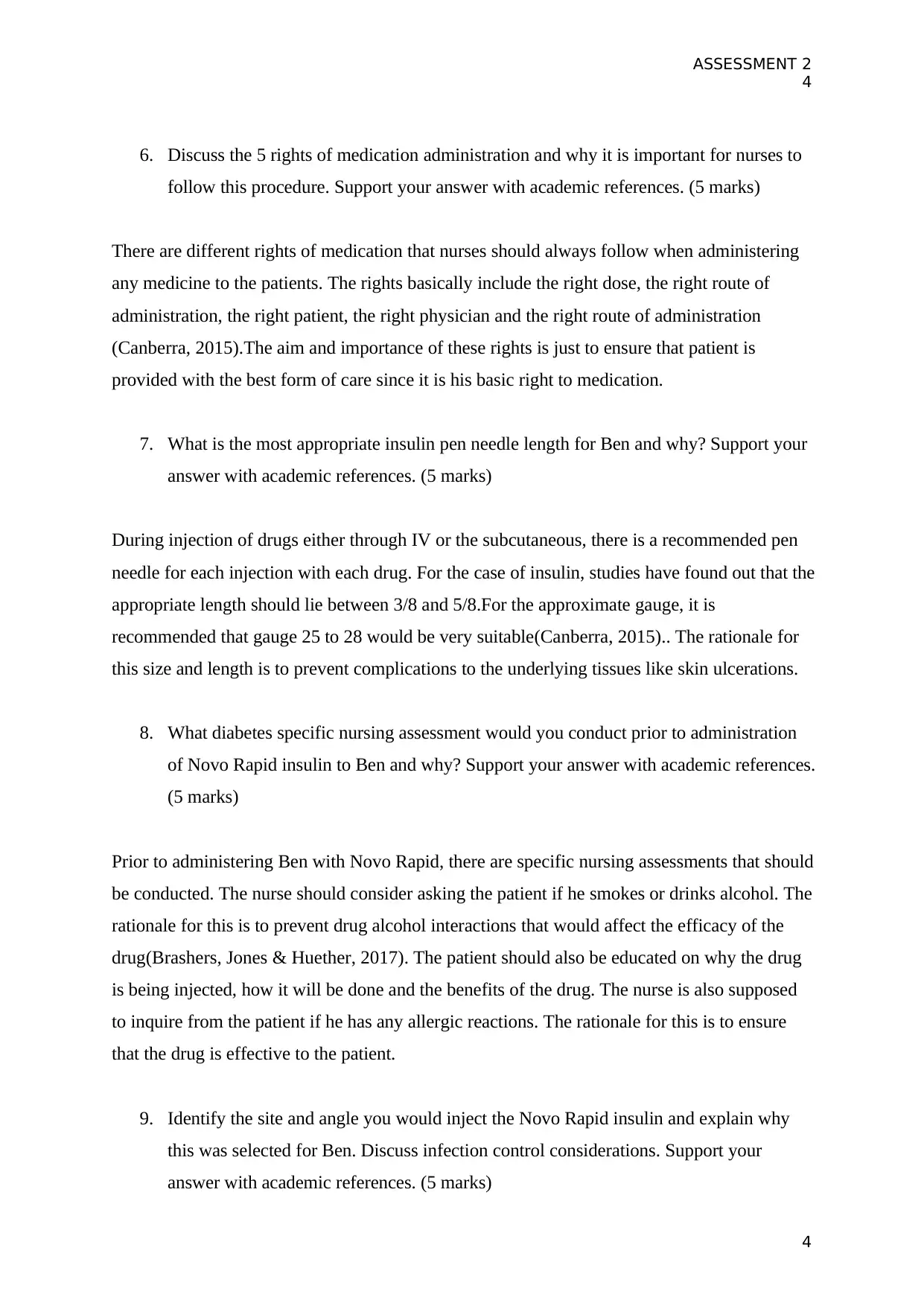
ASSESSMENT 2
4
6. Discuss the 5 rights of medication administration and why it is important for nurses to
follow this procedure. Support your answer with academic references. (5 marks)
There are different rights of medication that nurses should always follow when administering
any medicine to the patients. The rights basically include the right dose, the right route of
administration, the right patient, the right physician and the right route of administration
(Canberra, 2015).The aim and importance of these rights is just to ensure that patient is
provided with the best form of care since it is his basic right to medication.
7. What is the most appropriate insulin pen needle length for Ben and why? Support your
answer with academic references. (5 marks)
During injection of drugs either through IV or the subcutaneous, there is a recommended pen
needle for each injection with each drug. For the case of insulin, studies have found out that the
appropriate length should lie between 3/8 and 5/8.For the approximate gauge, it is
recommended that gauge 25 to 28 would be very suitable(Canberra, 2015).. The rationale for
this size and length is to prevent complications to the underlying tissues like skin ulcerations.
8. What diabetes specific nursing assessment would you conduct prior to administration
of Novo Rapid insulin to Ben and why? Support your answer with academic references.
(5 marks)
Prior to administering Ben with Novo Rapid, there are specific nursing assessments that should
be conducted. The nurse should consider asking the patient if he smokes or drinks alcohol. The
rationale for this is to prevent drug alcohol interactions that would affect the efficacy of the
drug(Brashers, Jones & Huether, 2017). The patient should also be educated on why the drug
is being injected, how it will be done and the benefits of the drug. The nurse is also supposed
to inquire from the patient if he has any allergic reactions. The rationale for this is to ensure
that the drug is effective to the patient.
9. Identify the site and angle you would inject the Novo Rapid insulin and explain why
this was selected for Ben. Discuss infection control considerations. Support your
answer with academic references. (5 marks)
4
4
6. Discuss the 5 rights of medication administration and why it is important for nurses to
follow this procedure. Support your answer with academic references. (5 marks)
There are different rights of medication that nurses should always follow when administering
any medicine to the patients. The rights basically include the right dose, the right route of
administration, the right patient, the right physician and the right route of administration
(Canberra, 2015).The aim and importance of these rights is just to ensure that patient is
provided with the best form of care since it is his basic right to medication.
7. What is the most appropriate insulin pen needle length for Ben and why? Support your
answer with academic references. (5 marks)
During injection of drugs either through IV or the subcutaneous, there is a recommended pen
needle for each injection with each drug. For the case of insulin, studies have found out that the
appropriate length should lie between 3/8 and 5/8.For the approximate gauge, it is
recommended that gauge 25 to 28 would be very suitable(Canberra, 2015).. The rationale for
this size and length is to prevent complications to the underlying tissues like skin ulcerations.
8. What diabetes specific nursing assessment would you conduct prior to administration
of Novo Rapid insulin to Ben and why? Support your answer with academic references.
(5 marks)
Prior to administering Ben with Novo Rapid, there are specific nursing assessments that should
be conducted. The nurse should consider asking the patient if he smokes or drinks alcohol. The
rationale for this is to prevent drug alcohol interactions that would affect the efficacy of the
drug(Brashers, Jones & Huether, 2017). The patient should also be educated on why the drug
is being injected, how it will be done and the benefits of the drug. The nurse is also supposed
to inquire from the patient if he has any allergic reactions. The rationale for this is to ensure
that the drug is effective to the patient.
9. Identify the site and angle you would inject the Novo Rapid insulin and explain why
this was selected for Ben. Discuss infection control considerations. Support your
answer with academic references. (5 marks)
4
Secure Best Marks with AI Grader
Need help grading? Try our AI Grader for instant feedback on your assignments.
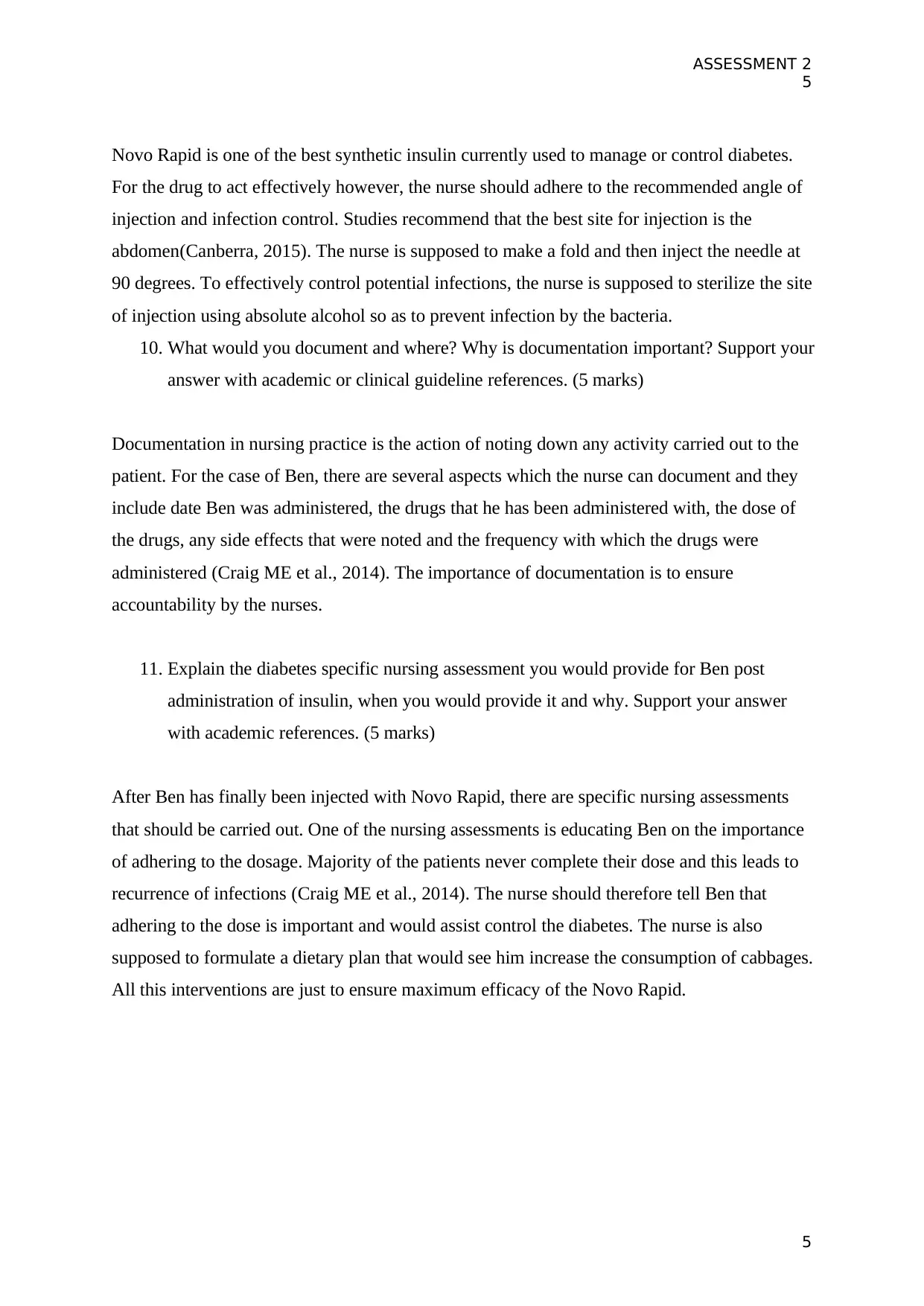
ASSESSMENT 2
5
Novo Rapid is one of the best synthetic insulin currently used to manage or control diabetes.
For the drug to act effectively however, the nurse should adhere to the recommended angle of
injection and infection control. Studies recommend that the best site for injection is the
abdomen(Canberra, 2015). The nurse is supposed to make a fold and then inject the needle at
90 degrees. To effectively control potential infections, the nurse is supposed to sterilize the site
of injection using absolute alcohol so as to prevent infection by the bacteria.
10. What would you document and where? Why is documentation important? Support your
answer with academic or clinical guideline references. (5 marks)
Documentation in nursing practice is the action of noting down any activity carried out to the
patient. For the case of Ben, there are several aspects which the nurse can document and they
include date Ben was administered, the drugs that he has been administered with, the dose of
the drugs, any side effects that were noted and the frequency with which the drugs were
administered (Craig ME et al., 2014). The importance of documentation is to ensure
accountability by the nurses.
11. Explain the diabetes specific nursing assessment you would provide for Ben post
administration of insulin, when you would provide it and why. Support your answer
with academic references. (5 marks)
After Ben has finally been injected with Novo Rapid, there are specific nursing assessments
that should be carried out. One of the nursing assessments is educating Ben on the importance
of adhering to the dosage. Majority of the patients never complete their dose and this leads to
recurrence of infections (Craig ME et al., 2014). The nurse should therefore tell Ben that
adhering to the dose is important and would assist control the diabetes. The nurse is also
supposed to formulate a dietary plan that would see him increase the consumption of cabbages.
All this interventions are just to ensure maximum efficacy of the Novo Rapid.
5
5
Novo Rapid is one of the best synthetic insulin currently used to manage or control diabetes.
For the drug to act effectively however, the nurse should adhere to the recommended angle of
injection and infection control. Studies recommend that the best site for injection is the
abdomen(Canberra, 2015). The nurse is supposed to make a fold and then inject the needle at
90 degrees. To effectively control potential infections, the nurse is supposed to sterilize the site
of injection using absolute alcohol so as to prevent infection by the bacteria.
10. What would you document and where? Why is documentation important? Support your
answer with academic or clinical guideline references. (5 marks)
Documentation in nursing practice is the action of noting down any activity carried out to the
patient. For the case of Ben, there are several aspects which the nurse can document and they
include date Ben was administered, the drugs that he has been administered with, the dose of
the drugs, any side effects that were noted and the frequency with which the drugs were
administered (Craig ME et al., 2014). The importance of documentation is to ensure
accountability by the nurses.
11. Explain the diabetes specific nursing assessment you would provide for Ben post
administration of insulin, when you would provide it and why. Support your answer
with academic references. (5 marks)
After Ben has finally been injected with Novo Rapid, there are specific nursing assessments
that should be carried out. One of the nursing assessments is educating Ben on the importance
of adhering to the dosage. Majority of the patients never complete their dose and this leads to
recurrence of infections (Craig ME et al., 2014). The nurse should therefore tell Ben that
adhering to the dose is important and would assist control the diabetes. The nurse is also
supposed to formulate a dietary plan that would see him increase the consumption of cabbages.
All this interventions are just to ensure maximum efficacy of the Novo Rapid.
5
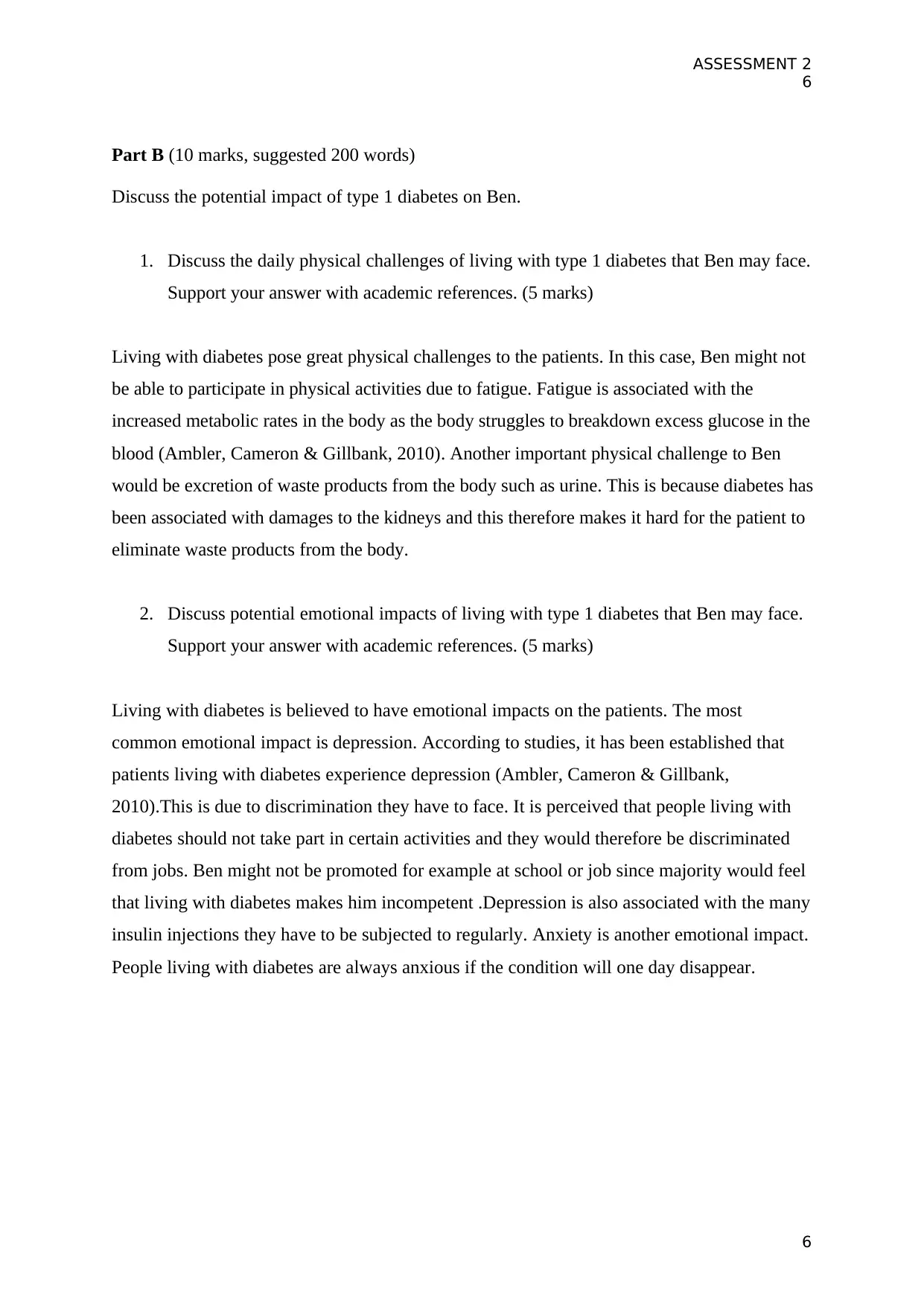
ASSESSMENT 2
6
Part B (10 marks, suggested 200 words)
Discuss the potential impact of type 1 diabetes on Ben.
1. Discuss the daily physical challenges of living with type 1 diabetes that Ben may face.
Support your answer with academic references. (5 marks)
Living with diabetes pose great physical challenges to the patients. In this case, Ben might not
be able to participate in physical activities due to fatigue. Fatigue is associated with the
increased metabolic rates in the body as the body struggles to breakdown excess glucose in the
blood (Ambler, Cameron & Gillbank, 2010). Another important physical challenge to Ben
would be excretion of waste products from the body such as urine. This is because diabetes has
been associated with damages to the kidneys and this therefore makes it hard for the patient to
eliminate waste products from the body.
2. Discuss potential emotional impacts of living with type 1 diabetes that Ben may face.
Support your answer with academic references. (5 marks)
Living with diabetes is believed to have emotional impacts on the patients. The most
common emotional impact is depression. According to studies, it has been established that
patients living with diabetes experience depression (Ambler, Cameron & Gillbank,
2010).This is due to discrimination they have to face. It is perceived that people living with
diabetes should not take part in certain activities and they would therefore be discriminated
from jobs. Ben might not be promoted for example at school or job since majority would feel
that living with diabetes makes him incompetent .Depression is also associated with the many
insulin injections they have to be subjected to regularly. Anxiety is another emotional impact.
People living with diabetes are always anxious if the condition will one day disappear.
6
6
Part B (10 marks, suggested 200 words)
Discuss the potential impact of type 1 diabetes on Ben.
1. Discuss the daily physical challenges of living with type 1 diabetes that Ben may face.
Support your answer with academic references. (5 marks)
Living with diabetes pose great physical challenges to the patients. In this case, Ben might not
be able to participate in physical activities due to fatigue. Fatigue is associated with the
increased metabolic rates in the body as the body struggles to breakdown excess glucose in the
blood (Ambler, Cameron & Gillbank, 2010). Another important physical challenge to Ben
would be excretion of waste products from the body such as urine. This is because diabetes has
been associated with damages to the kidneys and this therefore makes it hard for the patient to
eliminate waste products from the body.
2. Discuss potential emotional impacts of living with type 1 diabetes that Ben may face.
Support your answer with academic references. (5 marks)
Living with diabetes is believed to have emotional impacts on the patients. The most
common emotional impact is depression. According to studies, it has been established that
patients living with diabetes experience depression (Ambler, Cameron & Gillbank,
2010).This is due to discrimination they have to face. It is perceived that people living with
diabetes should not take part in certain activities and they would therefore be discriminated
from jobs. Ben might not be promoted for example at school or job since majority would feel
that living with diabetes makes him incompetent .Depression is also associated with the many
insulin injections they have to be subjected to regularly. Anxiety is another emotional impact.
People living with diabetes are always anxious if the condition will one day disappear.
6
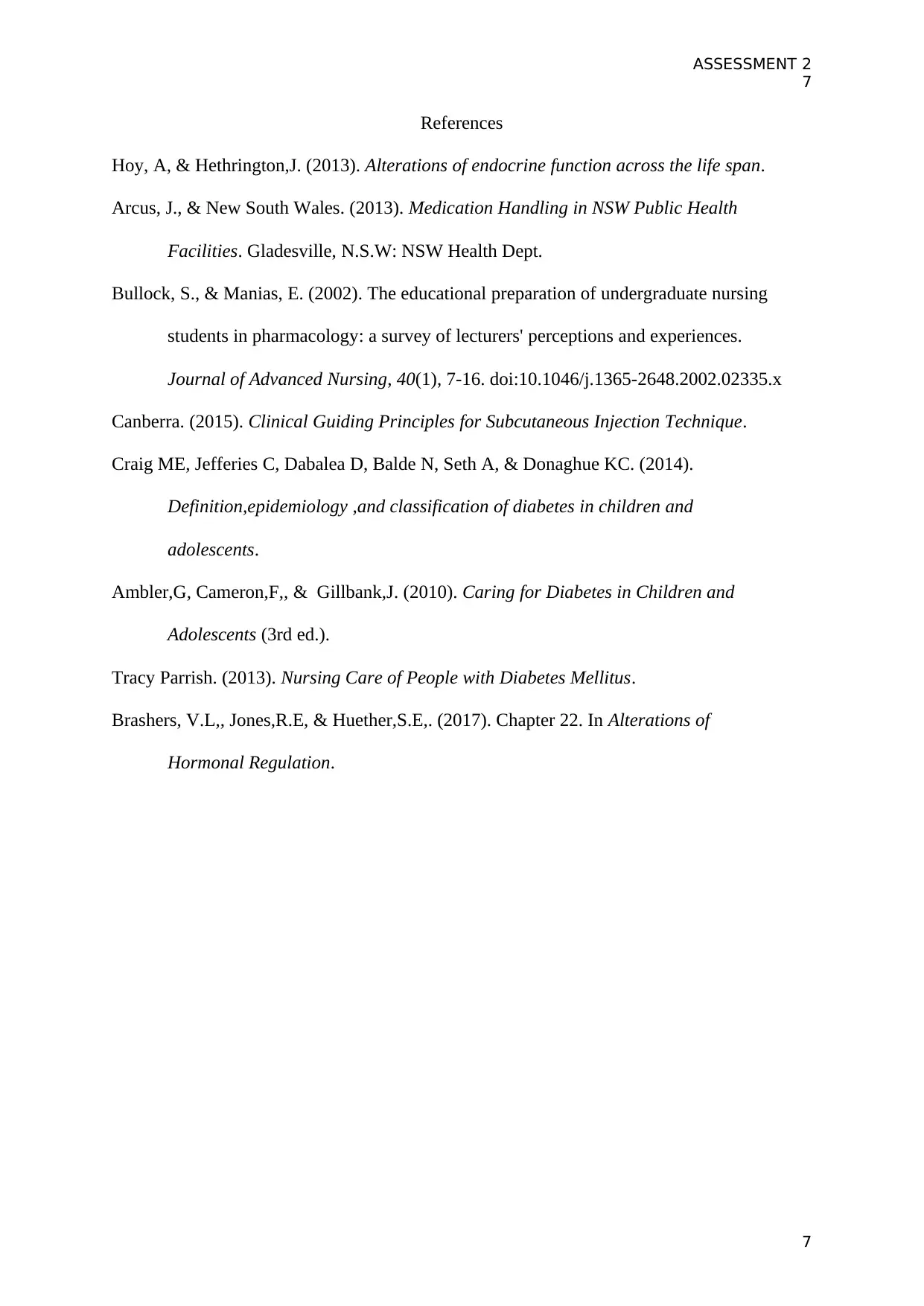
ASSESSMENT 2
7
References
Hoy, A, & Hethrington,J. (2013). Alterations of endocrine function across the life span.
Arcus, J., & New South Wales. (2013). Medication Handling in NSW Public Health
Facilities. Gladesville, N.S.W: NSW Health Dept.
Bullock, S., & Manias, E. (2002). The educational preparation of undergraduate nursing
students in pharmacology: a survey of lecturers' perceptions and experiences.
Journal of Advanced Nursing, 40(1), 7-16. doi:10.1046/j.1365-2648.2002.02335.x
Canberra. (2015). Clinical Guiding Principles for Subcutaneous Injection Technique.
Craig ME, Jefferies C, Dabalea D, Balde N, Seth A, & Donaghue KC. (2014).
Definition,epidemiology ,and classification of diabetes in children and
adolescents.
Ambler,G, Cameron,F,, & Gillbank,J. (2010). Caring for Diabetes in Children and
Adolescents (3rd ed.).
Tracy Parrish. (2013). Nursing Care of People with Diabetes Mellitus.
Brashers, V.L,, Jones,R.E, & Huether,S.E,. (2017). Chapter 22. In Alterations of
Hormonal Regulation.
7
7
References
Hoy, A, & Hethrington,J. (2013). Alterations of endocrine function across the life span.
Arcus, J., & New South Wales. (2013). Medication Handling in NSW Public Health
Facilities. Gladesville, N.S.W: NSW Health Dept.
Bullock, S., & Manias, E. (2002). The educational preparation of undergraduate nursing
students in pharmacology: a survey of lecturers' perceptions and experiences.
Journal of Advanced Nursing, 40(1), 7-16. doi:10.1046/j.1365-2648.2002.02335.x
Canberra. (2015). Clinical Guiding Principles for Subcutaneous Injection Technique.
Craig ME, Jefferies C, Dabalea D, Balde N, Seth A, & Donaghue KC. (2014).
Definition,epidemiology ,and classification of diabetes in children and
adolescents.
Ambler,G, Cameron,F,, & Gillbank,J. (2010). Caring for Diabetes in Children and
Adolescents (3rd ed.).
Tracy Parrish. (2013). Nursing Care of People with Diabetes Mellitus.
Brashers, V.L,, Jones,R.E, & Huether,S.E,. (2017). Chapter 22. In Alterations of
Hormonal Regulation.
7
1 out of 7
Related Documents
Your All-in-One AI-Powered Toolkit for Academic Success.
+13062052269
info@desklib.com
Available 24*7 on WhatsApp / Email
![[object Object]](/_next/static/media/star-bottom.7253800d.svg)
Unlock your academic potential
© 2024 | Zucol Services PVT LTD | All rights reserved.





